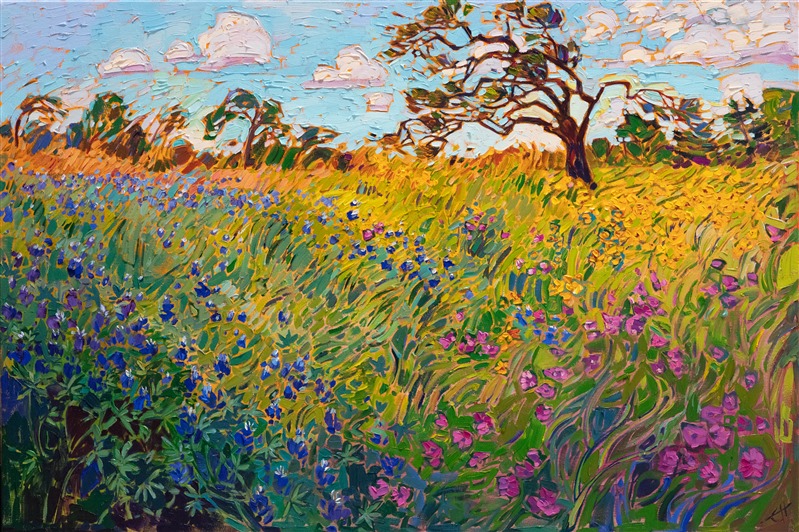Unique Wall Art Solutions: Oil Paintings for Sale
Unique Wall Art Solutions: Oil Paintings for Sale
Blog Article
Discovering All About Oil Paints: An Overview to Comprehending Their Elegance and Value
Oil paintings have actually astounded target markets for centuries, using a glimpse into the imaginative mastery of different periods. Their rich background is linked with ingenious strategies and extensive psychological expression. Comprehending the materials and techniques behind these artworks can boost gratitude. In addition, the marketplace for oil paints presents chances for collection agencies and investors alike. As one explores this interesting globe, the inquiry emerges: what makes an oil paint truly beneficial?
The History of Oil Paint: A Trip With Time
Although oil paint has roots that go back to ancient times, it truly prospered throughout the Renaissance, when artists found its convenience and rich shade potential. Early instances can be traced to the 7th century, with methods progressing especially throughout cultures. The tool ended up being popular in Northern Europe in the 15th century, especially through the jobs of musicians like Jan van Eyck, who originated its use for thorough realism and vibrant tones. This period noted a departure from tempera paints, allowing for better deepness and texture. As oil paint spread, it influenced numerous musicians, bring about work of arts by popular numbers such as Leonardo da Vinci and Rembrandt. The medium's legacy continues, forming the art globe well right into modern-day times.
Understanding Oil Paints: Products and Techniques
As musicians discover the world of oil paints, they run into a diverse variety of products and techniques that specify this medium. The key components of oil paint include pigments, which offer shade, and drying oils, such as linseed, that bind the pigments and help with application. Various additives can modify the paint's appearance and drying out time, improving convenience. Methods like glazing, where clear layers are developed, and impasto, which entails using thick paint, permit different aesthetic effects. Furthermore, the usage of brushes, palette knives, and also fingers can develop special structures and coatings. Recognizing these products and methods enables musicians to fully share their imagination and attain the wanted impact in their art work.
The Role of Color in Oil Paints
Shade plays a critical function in oil paintings, affecting both aesthetic appeal and emotional resonance. Comprehending color concept basics, including the relationships in between hues, can improve a musician's ability to share mood and atmosphere. Additionally, grasping shade mixing strategies enables higher depth and richness in a painting's combination.

Shade Theory Fundamentals
Understanding shade concept is essential for musicians collaborating with oil paints, as it develops the structure for creating harmonious and visually engaging make-ups. Color theory encompasses the research study of exactly how colors connect, the color wheel, and the partnerships between primary, second, and tertiary shades. Artists utilize corresponding shades to improve contrasts and produce focal factors, while comparable shades promote unity and cohesiveness within a piece. Additionally, the ideas of great and warm colors affect the assumption of deepness and space in a painting. Understanding these principles enables artists to manipulate shade properly, leading the viewer's eye and communicating their desired message. Mastery of color concept ultimately enriches a musician's capability to share emotions and ideas via their job.
Emotional Effect of Color
The emotional effect of shade in oil paints plays an essential duty in just how viewers regard and attach with artwork. Colors stimulate details sensations and state of minds, influencing the viewer's psychological state. Warm tones like reds and oranges can create a feeling of warmth and power, while amazing tones such as blues and eco-friendlies frequently evoke calmness or self-contemplation. Artists tactically pick color palettes to enhance narrative elements, directing the target market's emotional trip. The saturation and comparison of colors further amplify these impacts, attracting interest and creating emphasis. Eventually, the interaction of colors in oil paintings not only enhances their visual charm yet likewise offers as a powerful tool for emotional expression, improving the visitor's experience and interpretation.
Shade Mixing Techniques
While numerous elements of oil paint add to the total structure, grasping shade blending strategies is vital for achieving wanted impacts and depth. Color mixing can be approached through various approaches, including the subtractive and additive procedures. Additive blending includes incorporating colors of light, while subtractive blending counts on pigments, where shades blend to develop new shades. Artists commonly utilize a minimal combination to develop unified jobs, understanding the connections in between main, secondary, and tertiary shades. Techniques such as glazing and scumbling further enhance depth and luminosity. By skillfully blending shades, a musician can stimulate feelings, produce prime focus, and achieve a sense of realistic look, eventually elevating the paint's visual and psychological impact.
Famous Oil Painters and Their Iconic Works

Famous for their mastery of color and technique, oil painters have actually developed some of the most celebrated artworks in history. Renowned artists like Vincent van Gogh astounded audiences with his emotive brushwork in "Starry Evening," while Claude Monet's "Impression, Sunrise" prepared for Impressionism. Leonardo da Vinci's "Mona Lisa" stays a long-lasting icon of imaginative wizard, showcasing his skill in capturing human expression. At the same time, Rembrandt's "The Evening Watch" shows his ingenious use light and darkness. Various other noteworthy figures include Pablo Picasso, that reinvented modern art with his bold experimentation in works like "Les Demoiselles d'Avignon," and Georgia O'Keeffe, whose vibrant depictions of landscapes and blossoms helped specify American modernism. Each artist's unique design added greatly to the oil paint landscape.
Exactly how to Review the High Quality of an Oil Painting
Assessing the top quality of an oil painting involves a mindful assessment of workmanship techniques, along with an evaluation of shade and composition. Observing brushwork, layering, and the application of paint can reveal the artist's ability degree. Furthermore, the interplay of shades and the total setup of components contribute substantially to the painting's visual value.
Examining Craftsmanship Methods
A meticulous evaluation of workmanship strategies is important for identifying the quality of an oil paint. Critics must first check out the application of paint; thick, distinctive brushstrokes may suggest an experienced hand, while overly uniform applications can suggest an absence of deepness. oil paintings for sale. The layering method is additionally vital; the visibility of glazes and differed thickness can boost brightness and intricacy. In addition, the top quality of the materials made use of, such as the canvas and pigments, plays a considerable role in longevity and total aesthetic. Interest to detail in components like sides and shifts in between colors reflects the musician's commitment to their craft. Ultimately, these methods add to the paint's psychological impact and market price, serving as signs of the artist's skill and intent
Evaluating Color and Make-up
While assessing the high quality of an oil paint, one must concentrate on the interplay of color and composition, as these aspects are basic to the artwork's overall impact. Shade options can develop and evoke emotions mood; therefore, the musician's scheme need to be examined for harmony and contrast. A well-balanced structure routes the visitor's eye and develops a sense of unity. Musicians often utilize strategies like the guideline of thirds or leading lines to improve aesthetic rate of interest. Furthermore, the use of light and shadow can add depth, improving the three-dimensionality of the paint. Ultimately, an effective oil painting weds color and structure, involving the viewer and inviting a much deeper appreciation of the musician's vision and technique.
Taking care of and Preserving Oil Paintings
Proper care and conservation of oil paintings is important for preserving their stability and durability. To protect these art work, it is crucial to show them away from straight sunlight, which can create fading and discoloration. Keeping a steady environment with controlled temperature level and humidity additional help in stopping damage. Cleaning ought to be done gently making use of a soft, dry fabric, avoiding any rough chemicals that can damage the paint or varnish. Normal evaluations for indications of wear and tear, such as splitting or flaking, are recommended. When storing or transferring oil paintings, proper padding and framing are necessary to avoid physical injury. Eventually, attentive treatment adds to the aesthetic charm and value of oil paintings over time.
The Market for Oil Paintings: Accumulating and Spending
Understanding the marketplace characteristics for oil paintings is crucial for financiers and enthusiasts alike. The worth of these art work is influenced by various variables, consisting of the musician's reputation, historical relevance, and present fads. Collectors website usually seek items that reverberate personally while thinking about prospective gratitude in value. Public auctions and galleries function as main venues for trading, with prices rising and fall based upon demand and rarity. Purchasing oil paints calls for study into the marketplace, along with an understanding of credibility and provenance. Additionally, arising artists might use chances for significant returns, while developed names can command high rates. Overall, a tactical strategy to gathering can yield both visual enjoyment and monetary rewards.

Regularly Asked Concerns
What Are the Ecological Influences of Oil Painting Products?
The environmental impacts of oil paint products include the launch of volatile natural compounds (VOCs), dangerous waste generation, and resource extraction for pigments. These aspects add to contamination and environmental destruction, increasing problems amongst environmentally conscious artists and consumers.
Just How Do Different Canvases Impact Oil Painting Results?
Different canvases affect oil paint results significantly. Absorbency, texture, and surface area quality can modify paint application, drying out times, and shade vibrancy. Artists frequently pick certain canvases to achieve wanted effects and boost their creative expression.
Can Oil Paintings Be Restored if Harmed?
If harmed, Oil paints can certainly be brought back. Professional conservators make use of various strategies to fix tears, clean surfaces, and address staining, making certain that the artwork retains its initial beauty and value for future generations.
What Are the Indications of an Initial Oil Painting?
The indicators of an original oil paint include visible brush strokes, structure variants, and an unequal canvas weave (oil paintings for sale). Furthermore, authenticity may be validated via provenance, trademarks, and the presence of a varnish layer one-of-a-kind to oil mediums
Exactly How Has Innovation Influenced Modern Oil Painting Techniques?
Technology has significantly influenced contemporary oil paint methods by introducing digital devices for planning, boosted materials for texture and long life, and on the internet platforms for offering and sharing art, consequently expanding musicians' innovative possibilities and audience reach. Oil paint has roots that date back to ancient times, it genuinely grew during the Renaissance, when artists found its flexibility and abundant shade capacity. The psychological impact of shade in oil paintings plays an important function in how visitors view and connect with art work. While several facets of oil paint add to the general make-up, understanding shade blending methods is crucial for accomplishing wanted impacts and deepness. Examining the top quality of an oil painting involves a careful evaluation of craftsmanship techniques, as well as an evaluation of shade and composition. While evaluating the top quality of an oil paint, one have to concentrate on the interaction of color and structure, as these aspects are fundamental to the art work's overall influence.
Report this page